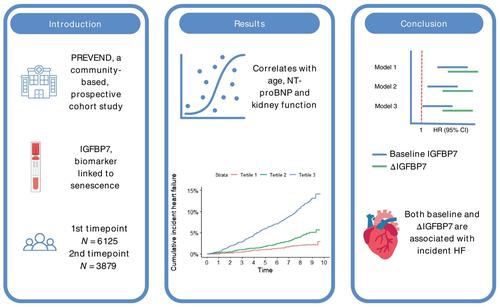当前位置:
X-MOL 学术
›
Eur. J. Heart Fail.
›
论文详情
Our official English website, www.x-mol.net, welcomes your
feedback! (Note: you will need to create a separate account there.)
Association of baseline and longitudinal changes in insulin‐like growth factor‐binding protein‐7 with the risk of incident heart failure: Data from the PREVEND study
European Journal of Heart Failure ( IF 16.9 ) Pub Date : 2024-07-17 , DOI: 10.1002/ejhf.3328 Sabrina Abou Kamar 1, 2 , Valentina Bracun 3 , Maissa El-Qendouci 1 , Nils Bomer 3 , Stephan J L Bakker 4 , Ron T Gansevoort 4 , Eric Boersma 1 , Isabella Kardys 1 , Rudolf A de Boer 1 , Navin Suthahar 1
European Journal of Heart Failure ( IF 16.9 ) Pub Date : 2024-07-17 , DOI: 10.1002/ejhf.3328 Sabrina Abou Kamar 1, 2 , Valentina Bracun 3 , Maissa El-Qendouci 1 , Nils Bomer 3 , Stephan J L Bakker 4 , Ron T Gansevoort 4 , Eric Boersma 1 , Isabella Kardys 1 , Rudolf A de Boer 1 , Navin Suthahar 1
Affiliation

|
AimSenescence is a major risk factor for heart failure (HF), and insulin‐like growth factor‐binding protein‐7 (IGFBP7) has been identified as an important senescence‐inducing factor. The aim of this study was to examine the value of baseline and repeat IGFBP7 measurements in predicting future HF among community‐dwelling Dutch adults from the Prevention of Renal and Vascular End‐stage Disease (PREVEND) study.Methods and resultsIndividuals without prevalent HF who attended PREVEND visits 2 and 4 median of 5.1 years apart (25th–75th percentile, 4.9–5.2) with measurements of IGFBP7 were included. We used Cox proportional hazards models to investigate the association between IGFBP7 and HF incidence. A total of 6125 participants attending visit 2 (mean ± standard deviation [SD] age 53.1 ± 12.2 years; 3151 [51.4%] men) were followed for a median of 8.4 (7.8–8.9) years, and 194 participants (3.2%) developed incident HF. Median baseline IGFBP7 concentration was 87.0 (75.1–97.3) ng/ml, and baseline IGFBP7 levels were significantly associated with risk for incident HF (HF risk factors adjusted hazard ratio [HR] per 1 SD change in log‐transformed IGFBP7: 1.22, 95% confidence interval [CI] 1.03–1.46). Baseline IGFBP7 was also significantly associated with incident HF in individuals with N‐terminal pro‐B‐type natriuretic peptide <125 ng/L. Among 3879 participants attending both visits 2 and 4 (mean ± SD age 57.5 ± 11.3 years; 1952 [50.3%] men), 93 individuals developed HF (after visit 4) during a median follow‐up of 3.2 (2.8–3.9) years. Median increase in IGFBP7 concentration between visits was 0.68 (−7.09 to 8.36) ng/ml, and changes in IGFBP7 levels were significantly associated with risk for incident HF (HF risk factors adjusted HR per 1 SD change in log‐transformed IGFBP7: 1.68, 95% CI 1.19–2.36).ConclusionsBoth baseline as well as repeat IGFBP7 measurements provide information about the risk of developing HF.
中文翻译:

胰岛素样生长因子结合蛋白 7 的基线和纵向变化与心力衰竭风险的关联:来自 PREVEND 研究的数据
衰老是心力衰竭(HF)的主要危险因素,胰岛素样生长因子结合蛋白7(IGFBP7)已被确定为重要的衰老诱导因素。本研究的目的是检查基线和重复 IGFBP7 测量值在预防肾脏和血管终末期疾病 (PREVEND) 研究中预测居住在社区的荷兰成年人未来心力衰竭的价值。方法和结果参加的没有流行心力衰竭的个人PREVEND 访视 2 和 4 的平均间隔为 5.1 年(第 25-75 个百分位数,4.9-5.2),并测量 IGFBP7。我们使用 Cox 比例风险模型来研究 IGFBP7 与心力衰竭发病率之间的关联。共有 6125 名参加第 2 次访视的参与者(平均±标准差 [SD] 年龄 53.1 ± 12.2 岁;3151 名 [51.4%] 男性)接受了中位随访 8.4 (7.8–8.9) 年,其中 194 名参与者 (3.2%)发生心力衰竭。中位基线 IGFBP7 浓度为 87.0 (75.1–97.3) ng/ml,基线 IGFBP7 水平与发生 HF 的风险显着相关(HF 风险因素调整后的风险比 [HR] 每对数转换 IGFBP7 的 1 个 SD 变化:1.22, 95 % 置信区间 [CI] 1.03–1.46)。对于 N 末端 B 型利钠肽原 <125 ng/L 的个体,基线 IGFBP7 也与心力衰竭显着相关。在参加第 2 次和第 4 次访视的 3879 名参与者中(平均 ± 标准差,年龄 57.5 ± 11.3 岁;1952 名 [50.3%] 男性),在中位随访 3.2 (2.8–3.9) 年期间,有 93 人出现心力衰竭(第 4 次访视后) 。两次就诊之间 IGFBP7 浓度的中位增量为 0.68(−7.09 至 8.36)ng/ml,IGFBP7 水平的变化与心力衰竭的风险显着相关(对数转换的 IGFBP7 每 1 个 SD 变化,心力衰竭风险因素调整 HR:1。68,95% CI 1.19–2.36)。结论基线和重复 IGFBP7 测量都提供了有关发生心力衰竭风险的信息。
更新日期:2024-07-17
中文翻译:

胰岛素样生长因子结合蛋白 7 的基线和纵向变化与心力衰竭风险的关联:来自 PREVEND 研究的数据
衰老是心力衰竭(HF)的主要危险因素,胰岛素样生长因子结合蛋白7(IGFBP7)已被确定为重要的衰老诱导因素。本研究的目的是检查基线和重复 IGFBP7 测量值在预防肾脏和血管终末期疾病 (PREVEND) 研究中预测居住在社区的荷兰成年人未来心力衰竭的价值。方法和结果参加的没有流行心力衰竭的个人PREVEND 访视 2 和 4 的平均间隔为 5.1 年(第 25-75 个百分位数,4.9-5.2),并测量 IGFBP7。我们使用 Cox 比例风险模型来研究 IGFBP7 与心力衰竭发病率之间的关联。共有 6125 名参加第 2 次访视的参与者(平均±标准差 [SD] 年龄 53.1 ± 12.2 岁;3151 名 [51.4%] 男性)接受了中位随访 8.4 (7.8–8.9) 年,其中 194 名参与者 (3.2%)发生心力衰竭。中位基线 IGFBP7 浓度为 87.0 (75.1–97.3) ng/ml,基线 IGFBP7 水平与发生 HF 的风险显着相关(HF 风险因素调整后的风险比 [HR] 每对数转换 IGFBP7 的 1 个 SD 变化:1.22, 95 % 置信区间 [CI] 1.03–1.46)。对于 N 末端 B 型利钠肽原 <125 ng/L 的个体,基线 IGFBP7 也与心力衰竭显着相关。在参加第 2 次和第 4 次访视的 3879 名参与者中(平均 ± 标准差,年龄 57.5 ± 11.3 岁;1952 名 [50.3%] 男性),在中位随访 3.2 (2.8–3.9) 年期间,有 93 人出现心力衰竭(第 4 次访视后) 。两次就诊之间 IGFBP7 浓度的中位增量为 0.68(−7.09 至 8.36)ng/ml,IGFBP7 水平的变化与心力衰竭的风险显着相关(对数转换的 IGFBP7 每 1 个 SD 变化,心力衰竭风险因素调整 HR:1。68,95% CI 1.19–2.36)。结论基线和重复 IGFBP7 测量都提供了有关发生心力衰竭风险的信息。











































 京公网安备 11010802027423号
京公网安备 11010802027423号